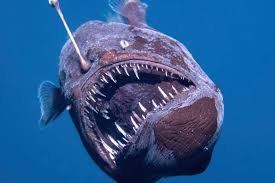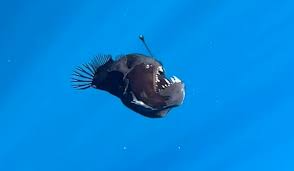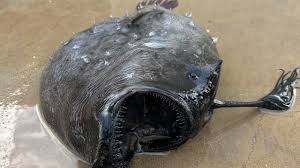Table of Contents
Scientific Classification
| Kingdom | Animalia |
| Phylum | Chordata |
| Class | Actinopterygii |
| Order | Lophiiformes |
| Family | Melanocetidae |
| Genus | Melanocetus |
| Species | Melanocetus johnsonii |
| Scientific Name | Melanocetus johnsonii |
1. Description
The humpback anglerfish, known scientifically as Melanocetus johnsonii, is both a captivating and eerie inhabitant of the deep sea. With its pitch-black, rounded body and peculiar facial features, this fish thrives in the depths of the ocean, where light is a distant memory—almost like something out of a legend.
Females are significantly larger than their male counterparts, reaching lengths of up to 18 cm (7 inches). You can easily identify them by the distinctive bioluminescent lure that dangles from their heads, which they use to entice prey, much like a fishing rod in the endless darkness of the ocean.
On the other hand, males are quite different; they are tiny, jawless parasites that rely entirely on females for survival. They don’t hunt or grow large; instead, they attach themselves to females for life, providing sperm in exchange for their existence..

2. Distribution
The humpback anglerfish is a fascinating creature that inhabits all the major oceans, but spotting one can be quite a challenge due to their deep-sea lifestyle. These mysterious fish thrive in the depths of the ocean, ranging from temperate to tropical waters, and can be found at astonishing depths of 200 to over 2000 meters (656 to 6561 feet).
You can find them scattered across the Atlantic, Pacific, and Indian Oceans, but don’t expect to see them often—sightings are pretty rare since their habitat is so difficult to access.
3. Habitat
The humpback anglerfish calls the bathypelagic zone home, which is often referred to as the “midnight zone.” This mysterious part of the ocean lies between 1,000 and 4,000 meters (3,280 to 13,123 feet) beneath the surface. It’s a pitch-black environment with bone-chilling temperatures and immense pressure.
What makes the humpback anglerfish truly remarkable is its ability to thrive in such harsh conditions. It either floats motionless or swims at a leisurely pace, conserving energy as it patiently waits for unsuspecting prey to swim within striking distance.
4. Diet
The humpback anglerfish is an ambush predator. It uses stealth and tricks to catch its prey. Its diet consists mainly of:
- Small fish
- Crustaceans
- Cephalopods (such as squid)
It uses its glowing lure to imitate tiny marine creatures. This tricks prey into coming closer. When it gets close, the anglerfish’s big jaw snaps shut quickly. Its clear, backward-pointing teeth are ready to catch prey.
Food is rare in the deep sea. So, it can eat prey nearly its own size. This is possible because of its stretchy stomach and flexible body.
5. Behavior
Unlike surface-dwelling fish, the humpback anglerfish is mostly solitary and exhibits minimal movement. It drifts or swims slowly to conserve energy.
Notably, its behavior revolves largely around feeding and reproduction. Bioluminescence is central to both:
- Feeding: Using the lure to attract prey.
- Mating: Possibly emitting chemical or light signals to attract males.
Another unique behaviour is sexual parasitism. Here, the male bites the female and fuses to her body. This unique but useful strategy helps reproduction in a place where finding mates is tough.

6. Lifespan
The lifespan of the humpback anglerfish remains a bit of a mystery, mainly because they thrive in such extreme environments. It’s believed that females tend to live longer than males, who usually have shorter lives unless they’re paired with a female.
Their slow metabolism and low levels of activity probably contribute to their longevity, much like other creatures that call the deep sea home.
7. Reproduction and Lifecycle
The reproductive process of the
- Males are born small and are driven entirely by the instinct to find a mate.
- Upon encountering a female, a male will bite her and release enzymes that fuse his body to hers.
- Over time, he loses his eyes and internal organs. He survives as a permanent appendage, giving sperm when the female is ready to spawn.
Females can carry multiple males on their bodies, ensuring sperm availability.
Spawning likely happens in the pelagic zone. Here, fertilized eggs float until they hatch. The larvae swim up to shallower waters and then sink into the deep sea as they grow.
8. Predators
Due to its deep-sea habitat, the humpback anglerfish has few known predators. However, potential threats include:
- Larger deep-sea fish
- Certain species of squid
- Human activities (indirectly through deep-sea trawling and environmental changes)
Its dark coloration and inaccessibility serve as natural defense mechanisms.

9. Adaptations
The humpback anglerfish has developed amazing adaptations to survive in the deep ocean:
Bioluminescent Lure
Its most famous trait is the glowing lure. It’s not just a flashlight; it’s a highly evolved tool for hunting. This glow comes from symbiotic bacteria that create light.
Expandable Jaw and Stomach
The anglerfish can eat prey as big as itself. This is possible because it has a wide jaw and an expandable gut. Meals are rare for this fish.
Extreme Sexual Dimorphism
This special way of reproducing helps them survive in the deep, empty sea, where finding a mate is hard.
Low Metabolic Rate
To survive in a resource-poor environment, it has developed a slow metabolism. This lets it go for long periods without food.
10. Conservation Status
The IUCN Red List marks the humpback anglerfish as “Least Concern.” This is mainly because it lives in remote and hard-to-reach parts of the ocean.
However, like many deep-sea creatures, it is indirectly threatened by:
- Deep-sea fishing practices
- Pollution, especially microplastics
- Climate change, which can alter oceanic conditions and food availability
More research is needed to understand population trends. We know very little about its abundance.

Conclusion
The humpback anglerfish is a fascinating blend of mystery and wonder from the deep sea. With its unusual appearance, somewhat intimidating features, and bizarre reproductive methods, it captivates marine biologists and nature enthusiasts alike.
Its survival tactics highlight just how adaptable life can be, even in the harshest environments, despite being rarely spotted. The glowing lure it uses is a powerful reminder that life can thrive, even in the darkest reaches of our planet.


